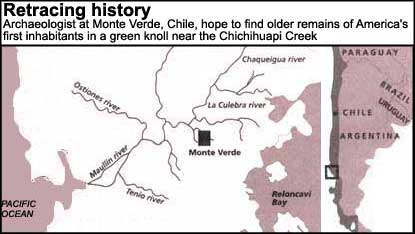In search of the past
 AFTER two decades of pitched intellectual battle over when people first inhabited the American continent, archaeologists have reached a peace treaty of sorts, acknowledging the victory of the Monte Verde excavators.
AFTER two decades of pitched intellectual battle over when people first inhabited the American continent, archaeologists have reached a peace treaty of sorts, acknowledging the victory of the Monte Verde excavators.
Monte Verde is on the east of Peurto Montt seaport in southern Chile. It is at this site where excavators found preserved wood, tied and knotted strings, hearths and even left over mastodon meat at an ancient hunter-gatherer camp.
With this evidence, Mario Pino, a geologist at the Southern University of Chile in Valdivia, and Tom Dillehay of the University of Kentucky in Lexington, established the site as the earliest place of human habitation in the Americas.
People had lived here 12,500 years ago. Some 1,300 years before the previously accepted date for earliest known Americans, derived from stone spear heads found in the 1930s near Clovis, New Mexico.
On a recent visit to Monte Verde, Pino hit upon the dark soil in the north bank of the Chichihuapi Creek with the pick end of his geologists hammer. He exposed more pieces of wood from the camp where prehistoric humans once lived. But the wood held less interest to him than the green knoll several hundred feet away, south of the creek. Pino said that cursory excavations had turned up possible remains of human habitation at Monte Verde 20,000 years earlier than the camp north of the creek. The two archaeologists are now planning more extensive and systematic excavations of the knoll site in January 2001. Their strategy will be to strip away six feet of topsoil with a bulldozer, then begin fine-tooth digging in the lower layers where evidence of human activity has emerged.
Says Pino, "There is no doubt about the age. The sediment layers (bearing the artifacts) are 33,000 years old." The date is based on radiocarbon examination of burned wood that scientists suspect came from hearths at the hunting camp.
The archaeologists found charcoal in three shallow depressions lined with scorched clay. Other evidence of human occupation includes 24 fractured pebbles, several of which were probably flaked by people using them to cut and scrape meat, hides and plants.
When independent archaeologists visited Monte Verde in 1997 and authenticated the younger camp site, Pino said, they also examined the material from the deeper, 33,000 year old layer.
Interestingly, Pino had expected the battle among archaeologists to continue. "But they said these are real human artifacts," he said. "We were surprised. We expected another fight," Pino added.
The findings will revolutionise research into one of the most intractable mysteries in American archaeology: when were the Americas first truly a New World?
